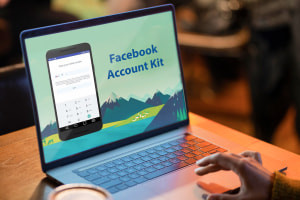Many websites require their users to register or log in to an account to have exclusive access to their services. This step usually involves the need to create complex and unique passwords for each user, typically changing them frequently to avoid data breaches. A user can have multiple accounts with different websites and memorising these passwords can be daunting. This need has resulted in the repetition of the same weak passwords, note pads containing passwords and the frequent use of the 'forgot password' feature. It's no surprise that passwords have become a popular target for cybercriminals. The Facebook Account Kit allows users to log into new apps and websites using only their phone number or email address. This course will teach you how to use the Facebook Account Kit to create password-less authentication using the PHP programming language.
How do you implement password authentication? Creating password-less authentication requires a web server. We begin by showing you how to download and install XAMPP, which you will use during the entire course. We'll then show you how to set up the Atom code editor you'll use to write your PHP code. After that, you'll study the fundamentals of HTML and CSS, including how to use the CSS library (Bootstrap). Having learned about these fundamentals, you will write your first PHP code within the HTML document. You'll learn about PHP variables and functions and how they work. In addition, we'll discuss the different types of operators used in PHP and explore the concept of PHP objects. This course provides a resource guide that contains a list of complete PHP operators that you can use within a PHP code. You will research PHP arrays and how you can use them.
Next, we demonstrate how to create a login page using the fundamental concepts of PHP. We'll be using a live secure website where our PHP code will be deployed and then implement the password-less authentication functionality using the Facebook app and the Account Kit. Once logged in, you'll create a Facebook developer account and learn how to create a new app. Next, examine how to log into your cPanel and create your PHP files directly on the web server. Next, we investigate how to design the user login page using HTML and CSS style tags, including creating the ‘form’ action and using the ‘post’ methods for a request-response between a client and server. Lastly, we cover how to initialise the Account Kit and use the login callback function. This course requires that learners have a basic knowledge of HTML, CSS and PHP. The Facebook Account Kit is easy and quick to adapt for both new and old web apps, allowing you to focus on developing your main product rather than designing a login system and managing password storage. So why wait? Register today.
What You Will Learn In This Free Course
View All Learning Outcomes View Less All Alison courses are free to enrol, study, and complete. To successfully complete this Certificate course and become an Alison Graduate, you need to achieve 80% or higher in each course assessment.
Once you have completed this Certificate course, you have the option to acquire an official Certificate, which is a great way to share your achievement with the world.
Your Alison certificate is:
- Ideal for sharing with potential employers.
- Great for your CV, professional social media profiles, and job applications.
- An indication of your commitment to continuously learn, upskill, and achieve high results.
- An incentive for you to continue empowering yourself through lifelong learning.
Alison offers 2 types of Certificate for completed Certificate courses:
- Digital Certificate: a downloadable Certificate in PDF format immediately available to you when you complete your purchase.
- Physical Certificate: a physical version of your officially branded and security-marked Certificate
All Certificate are available to purchase through the Alison Shop. For more information on purchasing Alison Certificate, please visit our FAQs. If you decide not to purchase your Alison Certificate, you can still demonstrate your achievement by sharing your Learner Record or Learner Achievement Verification, both of which are accessible from your Account Settings.











 Avg. Hours
Avg. Hours  Contains Video
Contains Video  CPD Accredited
CPD Accredited 
 Total XP:
Total XP: 
 Knowledge & Skills You Will Learn
Knowledge & Skills You Will Learn 







